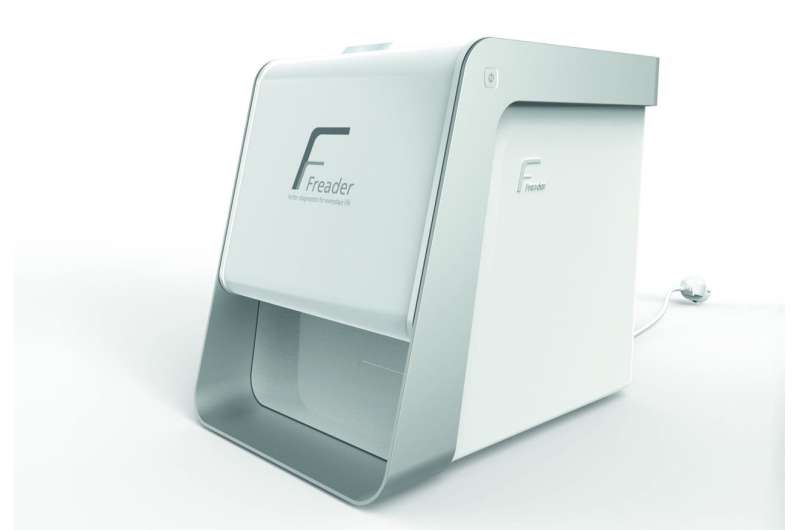Rapid test to detect salmonella in food

Anyone can get salmonella poisoning, but babies, toddlers, the elderly and people with immunodeficiencies are particularly susceptible. For people with weakened immune systems, the gastrointestinal disease can lead to serious complications. So far it has taken several days to detect salmonella in food. A new rapid test being developed by Fraunhofer researchers will detect the germs in less than eight hours.
Persistent diarrhea, vomiting, fever, stomach ache—these are all symptoms of salmonella poisoning. When a person consumes infected animal-based food products such as eggs and egg-based products (e.g. mayonnaise), milk, poultry, seafood or raw meat, the bacteria get into their gastrointestinal system and trigger the typical symptoms. When it comes to detecting the presence of salmonella in animal products, traditional microbiological techniques can take up to four days. This is a major problem for food manufacturers, who cannot wait around this long for the results before shipping out their goods. This leads, time and again, to costly product recalls. Significantly faster detection methods are therefore required. Together with the German microbiology and food analysis laboratory SELEKTIS GmbH, a team of researchers from the Fraunhofer Institute for Cell Therapy and Immunology, Branch Bioanalytics and Bioprocesses IZI-BB in Potsdam is developing a rapid test that is capable of determining whether food is contaminated with salmonella in less than eight hours. The business promotion banks for the federal states of Brandenburg (Investitionsbank des Landes Brandenburg, ILB) and Berlin (Investitionsbank des Landes Berlin, IBB) are sponsoring the project with funding from the European Regional Development Fund (ERDF).
Enrichment process reduced to 4-6 hours

Until now enriching the bacteria has been very time-consuming. Enrichment involves cultivating and propagating microbes, which are available only in limited quantities, in a liquid culture medium overnight, so that there is a sufficiently high bacterial count for subsequent detection. This process lasts about 18 hours, with three further days needed for the selective enrichment and incubation of the salmonellae in additional liquid media, for the streaking of a bacterial culture on agar plates, and for the serological test. Now the project partners have managed to reduce the initial lengthy enrichment process from 18 hours to between four and six hours. This was achieved using an innovative technique to cultivate the salmonellae: "We did this by creating a rapid culture with growth conditions optimized for salmonellae. By means of an innovative, optimized enrichment method, we are able to increase the concentration of the bacteria to such an extent that we can detect them using molecular biological methods after only a few hours. To do this, the DNA of the salmonellae is amplified and automatically detected, something we achieve by extracting the DNA of the salmonellae and amplifying them by molecular biological means to such an extent that they can be detected after a further 30 minutes. For the rapid test, we design the molecules that specifically detect the DNA of the salmonellae," explains Dr. Harald Peter. What is crucial is to obtain as high a concentration as possible of salmonella DNA in a short timeframe for the sensitive detection. The researchers can use fluorescent dyes to label the replicated DNA and detect it using capture molecules.
Automated system planned for sample preparation and pathogen detection
Although molecular biological detection techniques are already used in laboratories, they are rarely employed in fully automated processes—and up to now not in food diagnostics. For their project, Dr. Peter and his team plan to develop a system that automatically performs all procedures that are done manually, such as cultivation, enrichment, molecular biological replication and detection. In the future, all the components required will be integrated in a compact device—40 x 40 centimeters in size. Using some special molecular biological techniques, the researchers at Fraunhofer IZI-BB can skip certain DNA purification steps, for example, thus significantly simplifying and speeding up the process.
The German Food Hygiene Act (Lebensmittelhygiene-Verordnung) stipulates that a sample of 25 grams of meat must not contain a single salmonella bacterium. Consequently, the new rapid test has to be capable of detecting a single bacterium within six to eight hours—that is, within an average working day. A further task is to distinguish the salmonellae from other microorganisms," says Dr. Peter, outlining the challenge. A big advantage is that the test can also be applied to other food pathogens. To do this, the capture molecules merely need to be adapted to other organisms using a computer and gene databases.
Provided by Fraunhofer-Gesellschaft





















